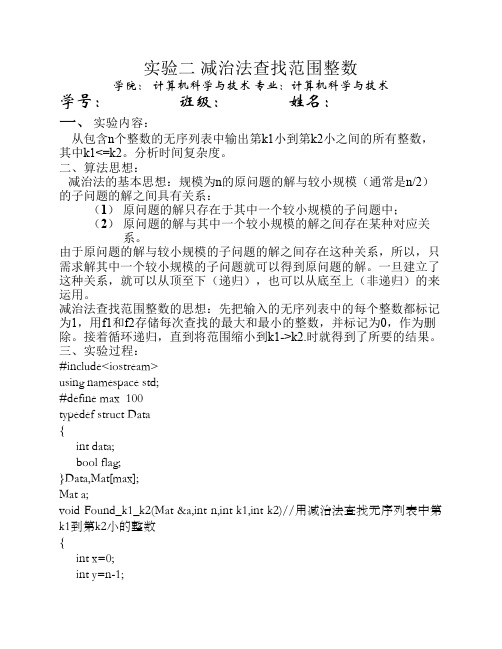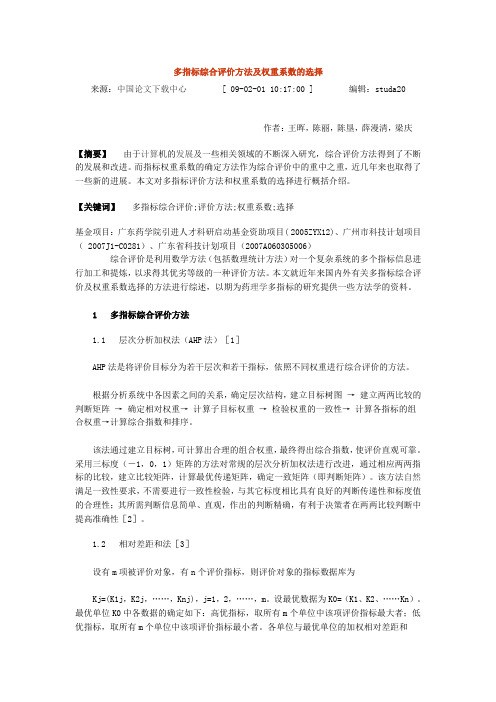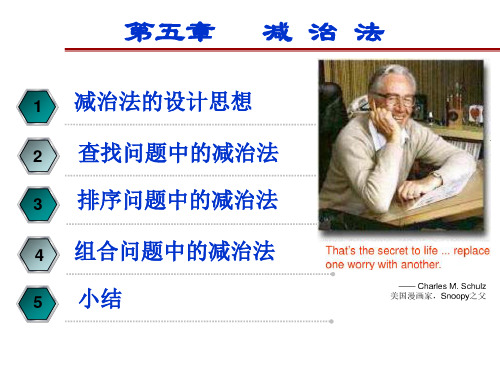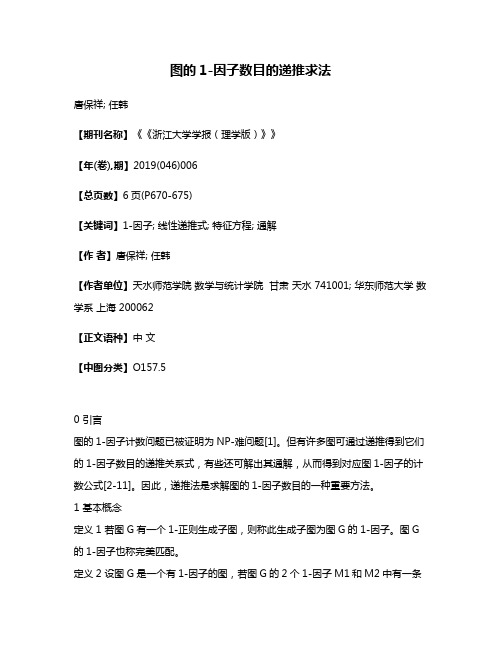12-13-01ADA09(减治法-减常因子算法I)
算法设计与分析 第5章 减治策略和变治策略

元素的求解过程与n个元素求解过程的联系,使问题的求解直接通
过表达式来求解,从而简化问题的求解难度。
一般采用自顶向下的分析方法,但求解时往往采用自底向上的
求解过程。这也是递归的方法。
(2)减去一个常量因子
在规模中减去一个常量因子,使求解的规模成倍的缩小,从而
提高问题求解的效率。
(3)减去的规模可变。 根据求解过程的变化来确定每次规模减少的程度。 具体实例:
减治策略及变治策略
减治策略
利用一个问题给定实例的解与该问题较小实例的解之间的关系, 使原问题求解过程简化的方法称之为减治策略。 可利用递归或者非递归的方法进行问题的求解。一般分为三类: (1)减去一个常量。 也就是在求解过程中将原来的求解规模减小一个固定的常数,
比如原来有n个元素,通过减治之后,编程n-1个元素,并且建立n个
实例
将原始序列先转化成另一种存储形式,然后再进行排序以简化
排序算法,比如:
1、堆以及堆排序
2、平衡二叉树
此外,复杂问题简化以降低求解难度: 1、多项式求解:霍纳法则
2、进制之间的转换问题。
此外,还有一些具体问题的求解方法均可采用变治策略。
1、直接插入排序
2、拓扑排序
3、全排列问题
4、子集问题
变治策略
变治策略也就是将原始问题变换成更容易求解的实例,然后对变化
后的实例进行求解。
主要ቤተ መጻሕፍቲ ባይዱ如下类型:
(1)变换为同样问题的更简单的实例,也就是实例化简。
(2)变换为同样问题实例的不同形式,也成为改变表现。
(3)变换为不同问题的实例,使问题更易求解,成为问题简化。
5-第五章 减治法

2.比较v和 A[x]
确定查找范围
5.6.3 二叉查找树的查找和插入
• 二叉查找树:左子树的值小于根顶点,右 子树大于根顶点。
小结
5.4 生成组台对象的算法
• 组合问题 1、计数 2、结构
组合问题
5.4.1 生成排列
用减一思想生成{1,2,…,n}所有排列。
Johnson-trotter算法
• 字典序---增序排队
5.4.2 生成子集
1、挤压序: 所 2、是否存在—种生成比特串的最小变化算法,使得每
一个比特串和它的直接前趋之间仅仅相差一 个比特 位。
n / 2 ,它要求找出这样一个元素,该元素比列表中的—半元素大,又比另—半元素
小。这个中间的值被称为中值,它在数理统计中是—个非常重要的量。
• 类似快速排序的分区做法
• 例
15 15
效率分析: 1)平均效率 2)最差效率
5.6.2 插值查找
插值查找用于有序数组,“插值”代替了折 半查找中的中间值 1.计算
• 最坏输入是一个严格递减的数组,这种输 入的比较次数是
• 最好的情况下(升序),在外部循环的每 次送代中,比较操作只执行一次
• 平均
5.2深度优先查找和广度忧先查找
• 什么叫图的遍历 从图的任意点出发沿着一些边访问图中的 所有顶点,且使每个顶点仅被访问一次,这就 叫图的遍历. • 我们来看一下图的遍历的两种方法: 1.深度优先搜索 2.广度优先搜索
第一种算法是深度优先查找的一个简单应用:执行一次DFS遍 历,并记住顶点变成死端(即退出遍历栈)的顺序。将该次序反过来 就得到了拓扑排序的一个解。
第二种算法基于减(减一)治技术的一个直 接实现:不断地做这样—件事,在余下的有向 图中求出一个源,它是一个没有输入边的顶点, 然后把它和所有从它出发的边都删除。
减治法

子问题 的规模是n/2 子问题的解
原问题的解
图5.1 减治法的典型情况(减半技术)
对于给定的整数a和非负整数n,计算an的值。
利用减治法,如果n=1,可以简单地返回a的值,如果n是偶数并且n>1,可 以把该问题的规模减半,即计算an/2的值,而且规模为n的解an和规模减半 的解an/2之间具有明显的对应关系:an=(an/2)2,如果n是奇数并且n>1,可 以先用偶指数的规则计算a(n-1),再把结果乘以a。所以,应用减治技术得到 如下计算方法:
排序问题中的减治法
堆排序
选择问题
堆排序
例
28 25 36 18 32 28 36 25 18 16 32 25 16 36 25 18 16 36 28 32
28
18 16
32
堆排序是利用堆(假设利用大根堆)的特性进 行排序的方法,其基本思想是:首先将待排序 的记录序列构造成一个堆,此时,选出了堆中 所有记录的最大者即堆顶记录,然后将它从堆 中移走(通常将堆顶记录和堆中最后一个记录 交换),并将剩余的记录再调整成堆,这样又 找出了次大的记录,以此类推,直到堆中只有 一个记录为止。
n 1 n 1
查找问题中的减治法
折半查找
二叉查找树
折半查找
在有序表{ 7, 14, 18, 21, 23, 29, 31, 35, 38, 42, 46, 49, 52 }中查找值为14的 记录的过程如图所示。
0 1
7
2
14
3
18
4
21
5
23
6
29
7
31
8
35
9
38
10
42
第 五 章 减治法

算 分 析 与 设 计
西南科技大学
金块问题
有一个老板有一袋金块。每个月将有两 名雇员会因其优异的表现分别被奖励一 个金块。按规矩,排名第一的雇员将得 到袋中最重的金块,排名最后的雇员将 得到袋中最轻的金块。如果每个月都有 新的金块周期性的加入袋中,则每个月 都必须找出最轻和最重的金块。假设有 一台比较重量的仪器,我们希望用最少 的比较次数找出最轻和最重的金块。
算 分 析 与 设 计
西南科技大学
直接插入排序实现方法
减一技术下,该方法遵循的思路是:假设对较 小数组 A[0..n-2]排序问题已经解决了,得到一 个大小为n-1的有序数组。然后将要排序的第n 个元素,插入到数组的适合位置上,得到大小 为n的有序数组 A[0..n-1]。伪代码如下: void InsertionSort(a[]) {for(i=1;i<n-1;i++) //从第二个记录起进行插入 for (j=i-1; j>=0;j--) if a[j+1]-(a[j]) < 0 Swap(a[j+1], a[j]); }
算 分 析 与 设 计
西南科技大学
俄式乘法☺ 俄式乘法☺
算法思想:两个A和B数相乘,把数A每 次除以2,直到为0为止,另一个数B则不 断加倍,若第数A未除尽时,则数B应加 上自己。 7×8的计算步骤: 7 8 3 16+ 8 1 32+ 16 + 8
算 分 析 与 设 计
西南科技大学
约瑟夫斯问题( 约瑟夫斯问题(一)
算 分 析 与 设 计
西南科技大学
减常数因子减治法
减常数因子减治法的一个 典型算法就是折半查找 (Bin_Search)。它搜索 一个排序好的数组,将查 找目标与数组的中间位置 的元素相比,比它大则递 归查找数组的左边,反之 亦然。这个每次迭代都将 问题减小为原来的1/2。 折半查找每次都消去一个 常数因子2,因此其时间 效率为O(logn)。
AA-chapter 5-01 减治法

18
插入排序
• 常用的插入排序有:
– 直接插入排序 – 折半插入排序 – 链表插入排序 – 希尔排序
• 它们的区别只在于 它们的区别 如何在排好序的序列 如何在排好序的序列 中寻找插入的位置。
算法分析与设计 兰州大学信息学院
19
5.1 直接插入排序
ALGORITHM InsertionSort( A[0 A[0..n ..n-1] ) // 对给定序列进行直接插入排序 // 输入:大小为n的无序序列A // 输出:按非递减排列的序列A for i ← 1 to n-1 do //把A[i]插入到A[1 A[1..i ..i-1] temp ← A[i] j ← i -1 while j ≥ 0 and A[j] > temp do A[j+1 A[j+ 1] ← A[j] j ← j-1 A[j+1 A[j+ 1] ← temp
InsertionSort( A[0 InsertionSort( A[0..n ..n-1] ) // 对给定序列进行直接插入排序 // 输入:大小为n的无序序列A // 输出:按非递减排列的序列A for i ← 1 to n-1 do temp ← A[i A[i] j ← i-1 while j ≥ 0 and A[j] > temp do A[j+1 A[j+ 1] ← A[j] j ← j-1 A[j+1 A[j+ 1] ← temp
算法分析与设计 兰州大学信息学院
21
5.1 直接插入排序 实例 (蓝色代表已排好序)
89 | 45 68 90 29 34 17 45 89 | 68 90 29 34 17
InsertionSort( A[0 InsertionSort( A[0..n ..n-1] ) // 对给定序列进行直接插入排序 // 输入:大小为n的无序序列A // 输出:按非递减排列的序列A for i ← 1 to n-1 do temp ← A[i A[i] j ← i-1 while j ≥ 0 and A[j] > temp do A[j+1 A[j+ 1] ← A[j] j ← j-1 A[j+1 A[j+ 1] ← temp
C++减治法查找范围整数

while(x<k1-1||y>k2-1) { int temp; int f1,f2;//存储最小和最大数的下标 f1=x; f2=y; for(int i=x; i<=y; i++) { if(a[f1].data>a[i].data) f1=i; if(a[f2].data<a[i].data) f2=i; } if(x<k1-1) { temp=a[x].data; a[x].data=a[f1].data; a[f1].data=temp; a[x].flag=0; x++; } if(y>k2-1) { temp=a[y].data; a[y].data=a[f2].data; a[f2].data=temp; a[y].flag=0; y--; } } } void Show(Mat &a,int n,int k1,int k2)
四、实验结果:
该算法的时间复杂度取决于n的大小和输入的 K1、K2的情况,最好情况是K1、K2恰好在输入的 无序列表的两端,此时不做运算,直接输出,时间 复杂度为O(0)。最坏情况是K1=K2=n/2时,此时做 n/2次运算,时间复杂度为O(n/2)。
{ cout<<"第"<<k1<<"小到"<<k2<<"小之间的所有整数有:"; for(int i=0; i<n; i++) { if(a[i].flag) cout<<a[i].data<<" "; } cout<<endl; } void main() { int choice; cout<<" 1: 执行程序! 2: 退出程序!"<<endl; do { cout<<"请选择你的操作:"; cin>>choice; switch(choice) { case 1: { int n; int k1,k2; cout<<"请输入无序列表n的大小:"; cin>>n; cout<<"请输入无序列表中的所有整数:"; for(int i=0; i<n; i++) { a[i].flag=1; cin>>a[i].data; } cout<<"请输入k1,k2的值:"; cin>>k1>>k2;
算法设计与分析-第5章-减治法

0 T (n) T (n / 2) 1
n 1 n 1
所以,通常来说,应用减治法处理问题的效率是很高的, 一般是O(log2n)数量级。
5.2 查找问题中的减治法
5.2.1 折半查找 5.2.2 二叉查找树 5.2.3 选择问题
5.2.1
一、问题描述:
折半查找
应用折半查找方法在一个有序序列中查找值为k的记 录。若查找成功,返回记录k在序列中的位置,若查找失 败,返回失败信息。
low=1
பைடு நூலகம்
18>14
mid=3
mid=7 31>14 high=6
high=13
high=2
mid=1
7<14
low=2
mid=2
14=14
5.2.1 折半查找
三、算法设计
算法5.1——折半查找
1. low=1;high=n; //设置初始查找区间 2. 测试查找区间[low,high]是否存在,若不存在,则查找失败; 否则 3. 取中间点mid=(low+high)/2; 比较k与r[mid],有以下三种情况: 3.1 若k<r[mid],则high=mid-1;查找在左半区进行,转2; 3.2 若k>r[mid],则low=mid+1;查找在右半区进行,转2; 3.3 若k=r[mid],则查找成功,返回记录在表中位置mid;
{ int data; //结点的值,假设查找集合的元素为整型
BiNode *lchild, *rchild; //指向左、右子树的指针 };
算法5.2——二叉排序树的查找
BiNode * SearchBST(BiNode *root, int k) { if (root= =NULL) return NULL; else if (root->data==k) return root; else if (k<root->data) return SearchBST(root->lchild, k); else return SearchBST(root->rchild, k); }
多指标综合评价方法及权重系数的选择

多指标综合评价方法及权重系数的选择来源:中国论文下载中心 [ 09-02-01 10:17:00 ] 编辑:studa20作者:王晖,陈丽,陈垦,薛漫清,梁庆【摘要】由于计算机的发展及一些相关领域的不断深入研究,综合评价方法得到了不断的发展和改进。
而指标权重系数的确定方法作为综合评价中的重中之重,近几年来也取得了一些新的进展。
本文对多指标评价方法和权重系数的选择进行概括介绍。
【关键词】多指标综合评价;评价方法;权重系数;选择基金项目:广东药学院引进人才科研启动基金资助项目( 2005ZYX12)、广州市科技计划项目( 2007J1-C0281)、广东省科技计划项目(2007A060305006)综合评价是利用数学方法(包括数理统计方法)对一个复杂系统的多个指标信息进行加工和提炼,以求得其优劣等级的一种评价方法。
本文就近年来国内外有关多指标综合评价及权重系数选择的方法进行综述,以期为药理学多指标的研究提供一些方法学的资料。
1 多指标综合评价方法1.1 层次分析加权法(AHP法)[1]AHP法是将评价目标分为若干层次和若干指标,依照不同权重进行综合评价的方法。
根据分析系统中各因素之间的关系,确定层次结构,建立目标树图→ 建立两两比较的判断矩阵→ 确定相对权重→ 计算子目标权重→ 检验权重的一致性→ 计算各指标的组合权重→计算综合指数和排序。
该法通过建立目标树,可计算出合理的组合权重,最终得出综合指数,使评价直观可靠。
采用三标度(-1,0,1)矩阵的方法对常规的层次分析加权法进行改进,通过相应两两指标的比较,建立比较矩阵,计算最优传递矩阵,确定一致矩阵(即判断矩阵)。
该方法自然满足一致性要求,不需要进行一致性检验,与其它标度相比具有良好的判断传递性和标度值的合理性;其所需判断信息简单、直观,作出的判断精确,有利于决策者在两两比较判断中提高准确性[2]。
1.2 相对差距和法[3]设有m项被评价对象,有n个评价指标,则评价对象的指标数据库为Kj=(K1j,K2j,……,Knj),j=1,2,……,m。
减治法(一)

减治法(⼀)这篇⽂章将讨论:1) 减治法的思想和策略2) ⼏个数据结构⾥⾯经典的使⽤减治策略的算法:插⼊排序,深度和⼴度优先查找,拓扑排序(都是减⼀治的)通过 1) 2)明⽩减治策略的基本思想和⽅法,也对经典数据结构做⼀番新的审视,从减治策略的⾓度来重新看待这些算法。
⽽在后⾯,将继续花⼏篇⽂章讨论减治策略的其他问题:排列问题,⼦集问题,减常因⼦算法,减可变规模算法。
----------------------------------------------------------------------------------------------------------------------------------------------------减治技术利⽤了⼀个问题给定实例的解和同样问题较⼩实例的解之间的某种关系。
⼀旦建⽴了这种关系,就可以从顶⾄下递归的来⽤该关系,也可以从底⾄上⾮递归的来运⽤该关系:1)减去⼀个常量2)减去⼀个常量因⼦3)减去的规模是可变的1) ⼀般来说减去的⼀个常量是1,即如果不断地解决n-1规模的问题就能解决n规模的问题,(偶⽽也有减2的,⽐较少)⽐如求a^n的值,既可以递归的从上到下求解,也可以⾮递归的从下往上构造(连续乘法,注意⽅法和蛮⼒⼀样,但思考问题的⾓度不⼀样)2) ⼀般来说减去的⼀个常数因⼦是2(即将原问题规模分为2),其实减常因⼦的减治法可以看做是分治的变种,只不过它只对划分⼦规模后的⼀个部分求解。
例如仍然是求a^n,我们可以这样来思考:3)对于减可变规模的例⼦,那就更少了,因为效率越⾼的算法显然越难找到。
⼀个例⼦是欧⼏⾥得算法,前⾯也写过了:总之,减治的3种⽅法,以及⼀个简单的例⼦就像上⾯所述。
-------------------------------------------------------------------------------------------------------------------------------------------------1,插⼊排序1) 最简单的排序⽅法,写过,也很简单。
减治法

第5章减治法(Decrease and Conquer)减治法的基本思想规模为n的原问题的解与较小规模(通常是n/2)的子问题的解之间具有关系:(1)原问题的解只存在于其中一个较小规模的子问题中;(2)原问题的解与其中一个较小规模的解之间存在某种对应关系。
由于原问题的解与较小规模的子问题的解之间存在这种关系,所以,只需求解其中一个较小规模的子问题就可以得到原问题的解。
2减治法的基本思想一旦建立了这种关系,就可以从顶至下(递归),也可以从底至上(非递归)的来运用Example, n!A top down (recursive) solutionA bottom up (iterative) solution3减治法的类型减治法有三种变种:1)减去一个常量2)减去一个常数因子3)减去的规模是可变的gcd(m, n)4减(一)治技术a problem of size nsubproblemof size n-1a solution to thesubprobleme.g., n!a solution tothe original problem5减(半) 治技术a problem of size nsubproblemof size n/2a solution to thesubprobleme.g., Binary searcha solution tothe original problem67典型的分治法subproblem 2 of size n /2subproblem 1 of size n /2a solution to subproblem 1 a solution to the original problema solution to subproblem 2a problem of size ne.g., mergesort减治与分治的区别考虑以下指数问题: 计算a n减一法Bottom-up: iterative (brute Force) Top-down:recursive分治法:减常因子法:a n= a*a*a*a*...*aa n= a n-1* a if n > 1= a if n = 1a n= a ⎣n/2 ⎦* a ⎡n/2⎤if n > 1= a if n = 1a n = (a n/2 ) 2if n is even and positive= (a(n-1)/2 ) 2 * a if n is odd and > 1 = a if n = 1O (log2n) O (n log2n)89111)2/(0)(>=⎩⎨⎧+=n n n T n T 所以,通常来说,应用减治法处理问题的效率是很高的,一般是O (log 2n)数量级。
因子表修正算法

因子表秩1修正算法的原理
一、系数矩阵不增阶时的因子表修正
• 原来网络方程系数矩阵A因子分解
A LDU
(4 16)
•网络变化后系数矩阵A~如下,M和N是N 1矢量,a是标量。
A~ A MaNT A ΔA
(4 17)
• 新的网络方程系数矩阵A~因子分解
A~ L~D~ U~
4 -18
• 将A和A~因子表分解形式代入(4 17)得
•式4 59中,将A增维后右下角的零不影响因子修正算法的
进行。
因子表的局部再分解
• 对于M和N的列阶次较高的场合,秩1因子表修正程序需要 被多次调用,使计算效率降低。
• 核心思想是只对因子表中受影响的行和列执行局部因子再
分解。这种作法比先修正再因子分解速度快。
•已知原网络矩阵A的因子分解为A LDU,写成方块如下:
m1aN1T M1aN1T
• 将A~ , A和A代入式(4 17)得:
A~ =A+A=~l1d~d~11
~l1d~1u~1
d~1u~L~11D~1U~ 1
=l1dd11
l1d1u1
d1u1 L1D1U1
+Mm11aann11
m1aN1T M1aN1T
4 24 4 25
4 26
因子表秩1修正算法的原理
4 54
a ladu a
lM Mu a1d1
A' L~D~ U~ A - Ma 1NT
u N d1la1NT
4 58
•
a分解
因子表得到l
a,d,u
,
a
其中d是对角线矩阵。
观察
式
4 58,由于A的因子表已知,可用系数矩阵不增阶时的
因子分析法基本原理之欧阳术创编

1 •因子分析法基本原理在对某一个问题进行论证分析时,采集大量多变量的数据能为我in的研究分析提供更为丰富的信息和增抽分析的精确度。
然而,这种方法不仅需要巨大的工作量,并且可能会因为变量之间存在相关性而増加了我们研究问题的复杂性。
因子分桥法就是从研究变量内部相关的依戦关系出发,把一些具有錯综复杂关系的变量旧结为少数几个综合因子的一种多变量统廿分桥方法。
这样我们就可以对原始的数据进行分类旧并,将相关比较密切的变量分别旧类,曲出多个综合指标,这些综合指标互不相关,即它们所综合的信息互相不重叠。
这些综合指标就称为因子或公共因子。
因子分桥法的基本思想是释观测变量进行分类,将相关性较髙,即取系比较紧密的分在同一类中,而不同类变量之间的相关性则较低,那么每一类变量实际上就代表了一个基本结构,即公共因子。
对于所研究的问题就是试图用最少个数的不可测的所谓公共因子的线性函数与特殊因子之和来描述原来观测的每一分量。
这样,就能相对容易地以较少的几个因子反映原资料的大部分信息,从而这到浓缩数据,以小见大,抓住问题本质和核心的目的。
因子分析法的核心是对若干综合指标进行因子分桥并提取公共因子,再以每个因子的方差贡献率作为权数与该因子的得分乘数之和构造得分函数。
因子分林法的数学表示为犯阵:X=AF+B,即:召=a J\ + a nft + %人+ …孤A + A勺=勺/ + a21fl + 如厶+ …a2kfk + 02< 心=色 / + a.2f2 + &33人+ …a恢 A + 03Xp=勺/ + a P ifi + 勺3厶+ …勺J + 0p(k w p)(1式)模型中,向量X(""2內,…,耳)是可观測葩机向量,即原始观测变量。
F"J,厶,…,人)是X*宀宀…,打的公共因子,即各个原观测变量的表达式中共同岀现的因子,是相互独立的不可观测的理论变量。
公共因子的具体含义必须结合实师研究问题来界定。
因子分析法指标选取原则

因子分析法指标选取原则因子分析法是利用样本数据所形成的一个具有多个变量的集合,对其进行因子分析。
一般来说,因子分析是指对某一变量进行综合分析。
它既包括主成分分析,也包括分析变量间是否存在相关关系的具体分析方法。
常用且有效的因子分析法有:因子分析法、 KMO (多元线性回归)法、因子分析法等。
一、定义因子分析是一种运用多个数据集来进行处理的统计学方法,利用统计软件对数据进行分析的一种分析方法。
其具体步骤是:首先,分析因子的数据来源,因子变量来源于多个数据;其次,分析变量之间是否存在相关关系;第三,进行因子分析操作;第四,使用计算公式将变量之间进行简单标准化处理,形成一个标准的量表来进行因子分析时要注意变量之间的相关关系。
假设该变量之间具有良好的关系,因此可以将各变量分别置于多个因子上。
1、因子变量的来源因子变量的定义是指一个变量包含两个以上的因子的集合,其中包含多个因子,这些因子的集合称为因子变量。
这些因子变量通常是指相关变量。
在实际的统计学研究中,需要考虑多种因素来共同影响因子和变量的表现:比如影响因素变量的解释能力、相关度、变量间关系等。
由于变量之间存在良好地相关关系,因此可以利用该变量来测量变量之间的关系。
2、根据因子分析的基本假设由于因子分析通常不需要再对变量进行编码,所以在因子分析过程中对原始数据的质量要求较低。
对于因子分析的基本假设,应以此为基础来进行。
假设该研究变量之间具有良好的关系:在不同变量之间存在相关关系,而且相互影响。
假设各变量之间是存在良好关系(并且相互影响)。
假设各变量之间具有良好关系:对于各个因子而言,这两个因素之间有一定密切的联系。
假设各因子能够共同解释变量之间有一定的共同含义:在各项目研究中,所有共同含义都代表着同一项目的两种特性和一种行为特性。
3、分析变量之间是否存在相关关系如果两个测试之间具有良好的关系,则可以认为两个变量之间具有相关性,假设两个问题之间是不存在相关关系的。
第5章 减治法

与 计
它成为死端时,DFS 过程结束。
算 顶点选择策略:搜索过程中,若某顶点有多个邻接顶点,可以按顶点
机
学 编号(或其他策略如优先值大小选择顶点)进行访问,下页图示。
院 DFS 搜索的非递归实现 —— 栈过程
黄 襄
1. 当前顶点入栈
念 2. 将栈顶顶点的下一个 未访问邻接顶点 入栈
若栈顶顶点无未访问邻接顶点,该顶点退栈(回溯)
西a c b
华
大
学
数 学
d
e
f
与
计 算
acd
(2)
机 学
表
b
c
f
院头
黄
襄顶
念
c d
a a
b e
e
(2)
(3) 边
(2)
数
点 e c d f (3)
f b e
(2)
图的邻接链表表示
访问顶点数与 n 的关系:
1. 每个表头顶点需要访问,以找到 该顶点开始的邻接顶点链
2. 每个链表的 剩余顶点 需要访问 剩余顶点数等于该链表的边数
DFS 检查图的连通性
西 华
从任意顶点开始DFS遍历,当遍历算法停止以后,检查是否全部顶点
大 都已访问过。若都访问过,此图是连通的。否则,此图不连通。因为
学
数 遍历算法不能到达的顶点,说明它与图的其他顶点没有路径可通。
学
与 计
DFS 检查图的无环性
算 机
如果从某个顶点到它的祖先顶点之间有一条回边,则该图存在回路,
随后两节讨论图的一些常用算法,可看作是 减一技术 的应用。
西 图是一种令人感兴趣的、有着广泛应用的数据结构。
华 大
人工智能算法Python语言版PPT第3章减治法

Else
Return False //图不是有向无环图,不存在拓扑排序
End If
时间复杂度:
()
拓扑排序 (4)
基于减一技术的拓扑排序(源删除算法)
C1
C4
C4
删除C1
C3
C2
删除C2
C3
C5
C2
C4
删除C3
删除C4
C5
C5
C4
C3
C5
拓扑排序表:
C2 C1 C3 C4 C5
C5
拓扑排序 (5)
课程修读的
先后次序
拓扑排序
拓扑排序 (6)
源删除算法的实现——基于数组(图存储:邻接矩阵)
用一个入度数组保存每个顶点的入度(无取出规则)
(1) 找到入度为0的点,将其存入数组中,再将其从图中删除(与它相关的边都
删除,相邻的顶点的入度均减1)
初始化队列,用于存储入度为0的顶点
For =0 To − 1 Do //遍历图中的顶点
If Indegree[]=0 Then //将入度为0的顶点加入队列
Enqueue(, )
If
End For
← ∅ //初始化用于存储输出顶点的列表
While ∅ Do
Dequeue(, ) //按入队顺序输出队列中的顶点e
减治法策略
大规模核酸检测:在席卷全球的新冠病毒感染检
测和疫情防控中,由于人口众多,如果对每个人
的核酸检测样本逐一检测以确诊感染病毒,实施
难度较大。
多人混检降低大规模筛查成本:针对40人以内的
待检测人员群体,可将被检测人员根据人数均分
第五章 减治法(包含作业)

Cbest (n) i n 1 (n)
i 1
2014-2-12 9
n 1
5.1 插入排序-效率分析
平均效率的精确分析基于对无序元素的研究,对于 随机序列的数组,
n Cavg (n) (n 2 ) 4
2
2014-2-12
10
排序算法-时间复杂度小节
插入排序最差Θ(n2) 最优 Θ(n) 平均 Θ(n2)
2014-2-12 7
5.1 插入排序-伪代码
ALGORITHM InsertionSort( A[0..n-1] )
// 对给定序列进行直接插入排序 // 输入:大小为n的无序序列A // 输出:按非递减排列的序列A
for i ← 1 to n-1 do temp ← A[i] j ← i-1 while j ≥ 0 and A[j] > temp do A[j+1] ← A[j] j ← j –1 A[j+1] ←temp
是否可以不产生1,2,3…n-1的这些中间结果?
2014-2-12
30
5.4.1 生成排列-JT
在排列的每一分量上画一个箭头。
移动元素:如果分量k 的箭头指向一个相邻的 较小元素,则该分量在排列中是移动的。 While 存在可移动元素
求最大的移动整数k,不断移动元素,直到没有元 素可移动为止,掉转所有大于k 的整数方向。
减常数(如1) :每此迭代规模减小n→n-1
2014-2-12
2
减治法-减常因子
减因子(如1/2):每此迭代规模减半n→ n/2
与分治法的区别?
2014-2-12
3
减治法-减可变规模
每此迭代减小的规模不同
第5章减治法.

1 减治法的设计思想 2 查找问题中的减治法 3 排序问题中的减治法 4 组合问题中的减治法 5 小结
1 减治法的设计思想
• 规模为n的原问题的解与较小规模的子问题的解之间如果具 有以下关系:
(1) 原问题的解只存在于其中一个较小规模的子问题中; (2) 原问题的解与其中一个较小规模的解之间存在某种确 定的对应关系。
查找区间减少一半(如果轴值恰好是序列的中值)。
分治法设计思想?两者在时间复杂度区别?
选择问题——实例
选择问题的查找过程示例 (查找第4小元素)
538164927 234156987 2341 1243
43 34
以5为轴值划分序列 4<5,只在左侧查找 以2为轴值划分序列 4>2,只在右侧查找 以4为轴值划分序列 4=4,轴值第4小元素
2一个简单的例子—两个序列的中位数
2一个简单的例子—两个序列的中位数
想法: 1. 分别求出两个序列的中位数,记为a和b; 2. 比较a和b,有下列三种情况:
① a = b:则a即为两个序列的中位数; ② a < b:则中位数只能出现在a和b之间,在序 列A中舍弃a之前的元素得到序列A1,在序列B中舍 弃b之后的元素得到序列B1; ③ a > b:则中位数只能出现在b和a之间,在序 列A中舍弃a之后的元素得到序列A1,在序列B中舍 弃b之前的元素得到序列B1; 3. 在A1和B1中分别求出中位数,重复上述过程,直 到两个序列中只有一个元素,则较小者即为所求。
{2, 4, 10, 15, 20}
3
15>10,结果在[10, 15]之间
舍弃15之后元素, {11,13,15}
舍弃10之前元素, {10,15,20}
图的1-因子数目的递推求法

图的1-因子数目的递推求法唐保祥; 任韩【期刊名称】《《浙江大学学报(理学版)》》【年(卷),期】2019(046)006【总页数】6页(P670-675)【关键词】1-因子; 线性递推式; 特征方程; 通解【作者】唐保祥; 任韩【作者单位】天水师范学院数学与统计学院甘肃天水 741001; 华东师范大学数学系上海 200062【正文语种】中文【中图分类】O157.50 引言图的1-因子计数问题已被证明为NP-难问题[1]。
但有许多图可通过递推得到它们的1-因子数目的递推关系式,有些还可解出其通解,从而得到对应图1-因子的计数公式[2-11]。
因此,递推法是求解图的1-因子数目的一种重要方法。
1 基本概念定义1 若图G有一个1-正则生成子图,则称此生成子图为图G的1-因子。
图G 的1-因子也称完美匹配。
定义2 设图G是一个有1-因子的图,若图G的2个1-因子M1和M2中有一条边不同,则称M1和M2是G的2个不同的1-因子。
定义3 长为n的2条路为P1=u0u1u2…un和P2=v0v1v2…vn,ui与vj连接一条边当且仅当|ij|=0或2(i,j∈ {0,1,2,…,n}),这样得到的图记为Wn,2,见图1。
定义4 设Ci=ui1ui2ui3ui4ui5ui6ui1是长为6的圈(i=1,2,…,n),给圈Cj与圈Cj+1加上边uj1uj+1,6,uj2uj+1,5,uj3uj+1,4(j=1,2,…,n-1)得到的图记为3-nC6,见图2。
图1 Wn,2图Fig.1 Figure of Wn,2图2 3-nC6图Fig.2Figure of 3-nC62 主要结果及其证明定理1 设图Wn,2的1-因子数为f(n),则其中,c1,c2,c3,c4为以下线性方程组的解:证明显然图Wn,2有1-因子。
为求f(n)的递推式,先定义2个图G1和G2,并求出它们的1-因子数的递推关系式。
将路xy的端点x和y分别与图Wn,2的顶点v0和u0各连接一条边,得到的图记为G1,见图3。
- 1、下载文档前请自行甄别文档内容的完整性,平台不提供额外的编辑、内容补充、找答案等附加服务。
- 2、"仅部分预览"的文档,不可在线预览部分如存在完整性等问题,可反馈申请退款(可完整预览的文档不适用该条件!)。
- 3、如文档侵犯您的权益,请联系客服反馈,我们会尽快为您处理(人工客服工作时间:9:00-18:30)。
//Input: An array A sorted in ascending order and a search K //Output: An index of the array’s element that is equal to K or -1 if there is no such element
If the key is smaller than the middle element, the key must be in the first half If the key is larger than the middle element, the key must be in the second half
2012-2013-01 《Design and Analysis of Algorithm》 SCUN
2012-12-27 13
Average-Case Analysis (cont.)
• So we can represent binary search as a binary tree:
2012-2013-01 《Design and Analysis of Algorithm》
• Euclid’s algorithm • The kth smallest element find algorithm • Interpolation search
2012-2013-01 《Design and Analysis of Algorithm》 SCUN
2012-12-27 5
What’s the difference? (example)
2012-2013-01 《Design and Analysis of Algorithm》 SCUN
2012-12-27 8
Binary search example:Find the key value 14
0 1 2 3 4 5 6 7 8 9 10 11 12
3 14 27 31 39 42 55 70 74 81 85 93 98
4
3 Types of Decrease and Conquer
Decrease by a constant (usually by 1)
• Insertion sort • Graph traversal algorithms (DFS and BFS) • Algorithms for generating permutations, subsets
2012-2013-01 《Design and Analysis of Algorithm》
SCUN
2012-12-27
3
Decrease-and-Conquer (basic idea)
1.
2. 3.
Reduce problem instance to smaller instance of the same problem Solve smaller instance Extend solution of smaller instance to obtain solution to original instance
k
[ r1 … … … rmid-1 ] rmid [ rmid+1 … … … rn ] (mid=(1+n)/2) k < rmid
k > rmid
First check the middle list element If the key matches the middle element, we are done
Problem of size n
subproblem of size n/2
solution to the subproblem solution to the original problem
2012-2013-01 《Design and Analysis of Algorithm》
SCUN
2012-12-27
2012-2013-01 《Design and Analysis of Algorithm》 SCUN
2012-12-27 12
Average-Case Analysis
Successful Search • If the search is always successful, there are n places (number of possible keys) the key could be found • We will consider each of these to be equivalent and so will give each a probability of 1/n • There is one place we check on the first pass, two places we could check on the second pass, and four places we could check on the third pass, and so on.
Chapter 5
Decrease and Conquer (I)
Introduction to Decrease-and-Conquer Decrease-by-a-Constant-Factor Algorithms The Binary Search Fake-coin Problem Russian Peasant Multiplication Josephus Problem
Combinatorial problem
• • Fake-coin problem (S5.5) Josephus problem (S5.5)
Binary Search (basic idea)
Used with a sorted list (the list is in increasing order)
low=0
27>14
mid=6 55>14 high=5
high=12
mid=2 high=1 mid=0
3<14
low=1 mid=1
14=14
SCUN
2012-12-27 9
2012-2013-01 《Design and Analysis of Algorithm》
The Binary Search Algorithm
Goals of the Lecis lecture, you should
• Master the basic idea and all kinds of variations of decrease and conquer technique • Master the binary search algorithm and its best-case, worstcase and average-case analysis • Understand the fake coin problem and its solution • Be familiar with the Russian peasant multiplication method • Understand the josephus problem and its solution
2012-12-27 6
The Application of Decrease by a constant factor technique
Search problem • The binary search (S4.3, P135-139)
Numerical problem
• Russian peasant multiplication (S5.5)
2012-2013-01 《Design and Analysis of Algorithm》
SCUN
2012-12-27
11
Worst-Case Analysis
In the worst case, we will either find the element on the last pass, or not find the element at all In each pass, only need 1 comparison. Hence, if we knew how many passes it has done, worst case is trivial If n = 2k-1, then there must be k = log(n+1) passes So, informally, we get: Tworst(n) = O(logn) If n is an arbitrary positive integer n, since after one pass, the algorithm faces the same situation but for an array half the size, we get the following recurrence relation for Tworst(n): Tworst(n) = Tworst ( n/2 ) + 1 n>1 Tworst(1) = 1 So, formally: Tworst(n) = logn + 1 = log(n+1) = O(logn)
2012-2013-01 《Design and Analysis of Algorithm》
SCUN
2012-12-27
10
Best-case Analysis
The input instances in which the target matches the middle element will lead to the best case. This means only one comparison is done. So we get: Tbest (n) = Ω(1)
